Uniting an early 1973 Porsche 911 RS 2.7 with a 2006 Porsche 911 GT3 RS 997.1
Separated by thirty-three years, this 911 Carrera RS 2.7 and first-generation 911 GT3 RS 997 share Porsche’s crucial ‘road racer’ DNA...
Words Steve Bennett
Photography Dan Sherwood
POWER OF RELATIVITY
Uniting an early RS 2.7 with a 997 GT3 RS.
RESTORED EARLY CARRERA RS 2.7 MEETS 997 GT3 RS — LEGENDARY 911 TRACK ATTACKERS UNITE
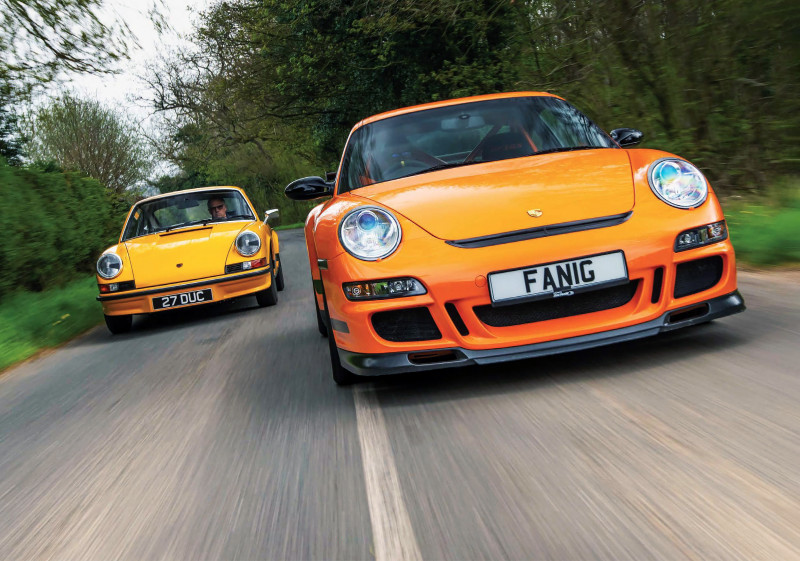
NOT ALL RENNSPORTS ARE EQUAL, NOT ALL ARE GREAT, AND NOT ALL WERE MADE TO WORK ON BOTH ROAD AND TRACK
It’s not often I would walk past a Signal Yellow Carrera RS 2.7 in favour of something newer, but in the case of the 997 GT3 RS, I have to make an exception. This water-cooled wonder is, you see, my favourite modern 911. Better than all the GT and RS-badged beasts which followed? It’s just my opinion, but yes. Can I justify this claim? Allow me to try. Before getting into the argument, it’s worth highlighting the fact we have a Carrera RS 2.7 on hand for a reason, even if this not-so-mellow yellow Rennsport isn’t quite the centre of attention. It is, of course, RS ground zero, the genesis of the legend. And this particular car deserves a swift about turn, because it’s one of the first five hundred examples of its kind. Build number 433 to be precise, registered on January 1st 1973. The RS 2.7 may be first of the breed, but to compare it with a first-generation 997 GT3 RS is to somewhat stretch credibility, surely? Well, not in the neverending process of 911 evolution — this interconnection makes the 911 so fascinating and relevant.
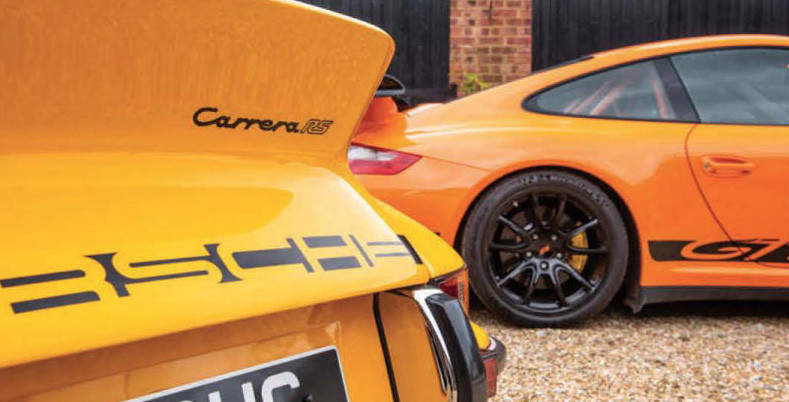
The RS 2.7 was developed and built for motorsport homologation at Porsche’s Weissach development centre, just as the 997 GT3 RS was thirty-three years later. The ‘road racer’ concept remains very much the same, but times and technology change, encouraging Porsche’s engineers to continually push the envelope.
THE ORIGINAL RS IS DELICATE, DEFT AND SEEMS TO REQUIRE BARELY ANY STEERING INPUT TO TURN INTO A CORNER
The RS 2.7 is very much an analogue 911 — there’s not a microchip to be found. Even the fuel injection system is virtually clockwork. Having said this, any car with fuel injection in 1973 was considered high-tech. This was, after all, the age of carburettors.
To develop the original RS, Porsche tuned into what it had and developed performance in the time-honoured way of power, weight, grip and braking. A process of more and less. Fast-forward to the age of the 997 and, of course, Weissach’s engineers had rather more in the way of resources and technology at their disposal, resulting in a Rennsport on the cusp of the analogue-to-fully-digital revolution. A bookend, if you like.

Above In addition to Porsches, Kevin owns a variety of fast Fords, various Morgans, Jaguars and even an Austin J40 pedal car. Facing page RS 2.7’s production date was 1st December 1972, with registration taking place on 1st January 1973
We’ll come to this, but first, a shout out to Kevin Kivlochan, who owns these two 911s. He’s a renowned winning historic racer and a regular at the Goodwood Revival and Le Mans Classic, albeit in his Shelby Cobras and historic Fords. He’s a sharing kind of fellow, co-driving with distinguished wheelmen, including Le Mans winner, Emanuele Pirro, former Formula One star, Eddie Cheever, and, significantly, the late Sir Stirling Moss.
Porschephiles we may be, but we can appreciate the V8 thunder of a Galaxy or Falcon, especially when the host Blue Oval is dressed in Alan Mann Racing’s red and gold livery. Kevin also has a penchant for the Lotus Cortina. Personally speaking, I’ll reserve a soft-spot for the Group 1 Capri in his collection. Wearing Fabergé/Brut 33 colours, it’s the 1970s summed up to a tee. In fact, I well remember seeing the car race at Thruxton and Silverstone in period. “Splash it all over,” as Barry Sheene, Kevin Keegan and Henry Cooper once said.
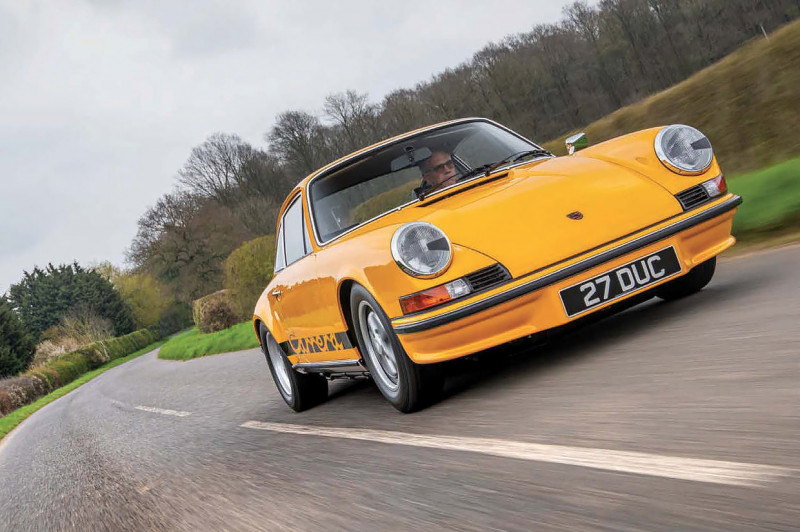
Above RS 2.7 lives among Kevin’s extensive collection of classics, including a 964 Carrera RS N/GT prototype.
Porsches? Kevin prefers his Stuttgart metal to be ready for the road. Regarding analogue 911s, he owns a 993 Turbo subjected to a factory GT2 conversion, which you may well see popping up in our sister title Classic Porsche before long. Oh, and he’s also in possession of a prototype 964 Carrera RS N/GT. It’s number six of the nine pre-production examples built and is most famous for being the promotional car featured in Porsche’s period press pictures. Subject to comprehensive restoration by independent marque specialist, RPM Technik, the work was overseen by former factory racing driver and legendary works motorsport engineer, Jürgen Barth, who was responsible for the 964 Carrera RS N/GT (and so much more) in the first place.
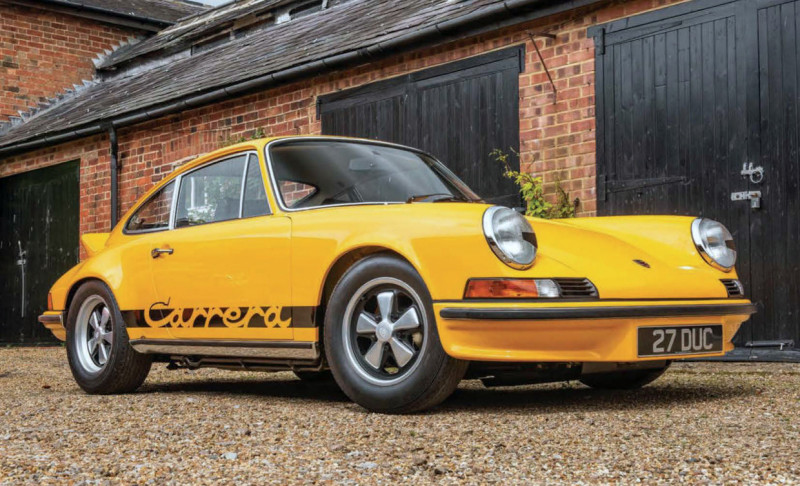
Above Now fully restored to original Touring specification, 9113600433 is one of the first five hundred Carrera RS 2.7s built.
SIGN OF THE TIMES
That Kevin has taste is clear. He’s also to be commended for ensuring his RS 2.7 (chassis number 9113600433) was returned a state of originality, which is no less than it deserves, given its early build status. Of course, back when this 911 rolled out of the factory, the notion it would be quite so venerated fifty years later was an unknown. And so, according to what any RS is built for, the car spent many years being used, abused, colour changed and generally fiddled about with. Not carelessly or with malintent, but just in keeping with its road and race purpose in life.

Originally sold new by the Otto Glocker Porsche Centre in Frankfurt, the car’s original early owners are unknown, although Kevin confirms it was converted to full Lightweight specification, fitted with a long-range tank and club-raced in Germany. The car passed through various hands and enthusiast owners in Europe, including Nürburgring race organiser and scrutineer, Rudi Phillipp, and Dirk Sadowski, proprietor of Lippstadt-based sports car sales centre, PS Automobiles.
Renowned RS dealer, Edmund Harris, imported the car into the UK in 1995, passing it on to Eoin Sloan, then RS Secretary for Porsche Club Great Britain. It stayed in the Sloan family by virtue of Eoin’s son, Andrew, taking ownership. Later, he exported the car to France, before selling it to Brian Goff at Barrowford-based Jasmine PorschaLink in 2002. 911 enthusiast, Ian Cox, added his name to the V5 in 2003. Those of you with a long memory will remember our showcase feature starring Ian’s 911 S 2.2. The article was published back in 2015, when he referred to buying this very RS. “When they were sensible money, it was a cheapie, helped by left-hand-drive and the fact it rolled out of the factory in Touring specification. I paid mid-thirties.” Different times.
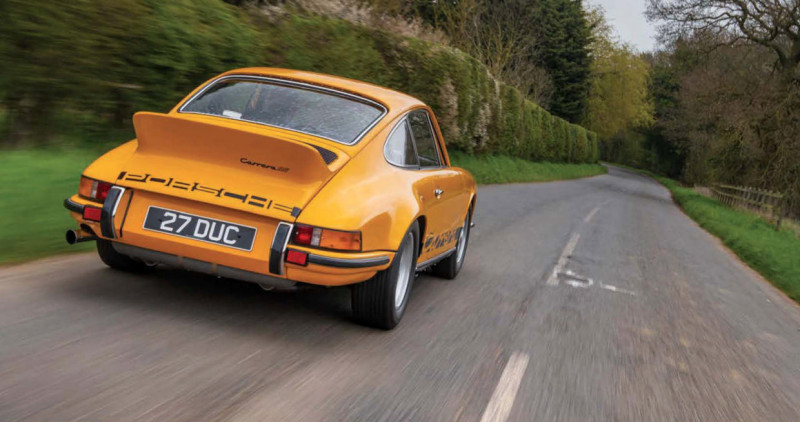
Above 210bhp might not sound much by today’s sports car standards, but in a car this light and this analogue, it feels supremely fast.
And so to Kevin, who purchased the RS in 2017 and then proceeded to use it regularly until 2020, when the decision was made to restore to full and original specification. Quite the challenge, although one he entrusted to renowned Porsche restorer, Gary Cook, founder of GDC Automotive in Milton Keynes. His assessment?
“It was typical of so many RSs,” he recalls. “Over the years, many of these cars have been messed around with. This RS started life as a Touring but was later converted to Lightweight specification. We didn’t realise quite what we had until we started stripping the car. Someone had clearly undersealed the floorpan early in the vehicle’s life. As we discovered, underneath this protective coating was the original painted finish, a distinguishing feature of a very early RS.” From that point on, it was important to restore the car as if time travel were possible, meaning Gary and his team used exactly the right parts. Despite being a ‘matching numbers’ RS, while superficially very presentable and drivable, many of its body panels had been replaced with later versions. Again, this isn’t unusual, particularly when you consider Porsche had stopped making the replacement parts.

Above and below It would be easy not to believe this gorgeously restored RS was once switched to Lightweight specification and raced hard in German club motorsport.
Gary scoured the world for the correct panels and, where possible, made sure they were date stamped to match the car’s early build status. For this sort of restoration, approximate simply won’t do. Porsche has since reintroduced lightweight RS panels to its manufacturing programme of parts for legacy models. This certainly makes the job a bit easier, but where incidental items weren’t available (and, in many instances, are still absent) from the Porsche Classic range, Gary had them 3D-printed. The plastic horn push, for example, is unique to the early RS, but pretty much unobtainable because the part was prone to breaking.
Other unique features included a particular patterned sound deadening material, which had to be replicated with a specially made press to stamp the correct pattern. Whoever said “don’t sweat the small stuff” clearly didn’t know anything about the restoration of a rare, air-cooled Porsche.
Below Gary Cook at GDC Automotive not only restored the car, but also takes care of all servicing and maintenance work.
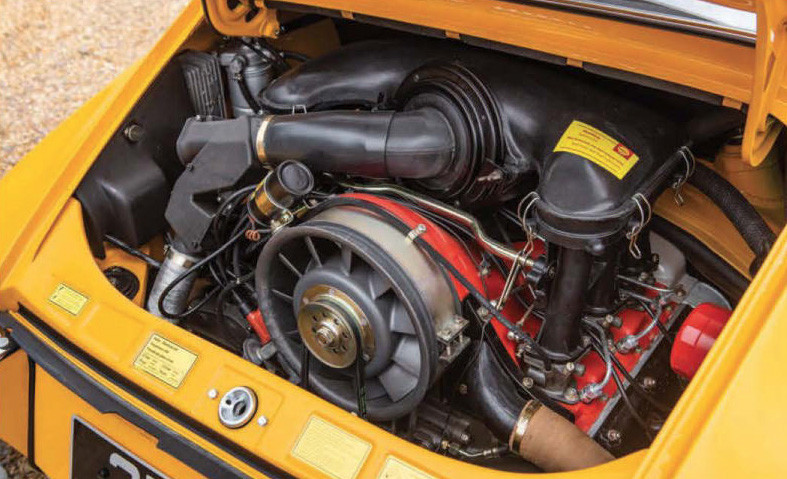
RS 2.7 number 433 now presents as one of the very best around, sitting perfectly on its fifteen-inch Fuchs and rolling on period-perfect Michelin rubber. To drive an early RS is a privilege and an education all at the same time. A privilege for very obvious reasons, and an education because without seat time in a 2.7, drawing any sort of comparison with later RS-labelled 911s is impossible. A life-changing experience? Well, sort of. In terms of the thrill of driving, the original RS is something revered to the point of mythology. It’s right up there: the tactile steering, the throttle response, the sheer lightweight get-up-and-go, not forgetting unique rear-engined balance. Then there’s the excitement brought by value and rarity. It’s impossible to ignore. It’s a cliché, but the RS 2.7 really does churn into life. It also clatters. The mechanical fuel injection adds a steady hornet-like drone to the soundtrack, plus the odd stumble and stutter at idle.
GETTING TO GRIPS
Time to drive. The long gear lever is equally long winded. It’s attached to the oft-maligned Type 915 gearbox, which slots into first with a familiar twang. Easing off the floor-mounted clutch pedal requires a strange balance of movement from the left foot, so much so your heel will lose contact with the carpet. The same strange sensation applies to every gear change. Likewise, every brake application. It’s all part of an air-cooled 911’s charm.

Funny pedals and notchy gear-change aside, early 911s have never been intimidating to drive. The RS 2.7 is no exception. The upright driving position affords a commanding view over the front wings and headlight cowls. Point these into a corner and you’ll immediately begin to understand how a 911 works.
The RS weighs little more than a thousand kilograms. This lightness matters — the car feels remarkably alive. Over fast undulating roads, it has a poise and balance feeling almost neutral, which is weird, because this is very much rear-engined Porsche. Funnily enough, it’s this trait projecting forward to the 997 GT3 RS, which we’ll come to shortly.
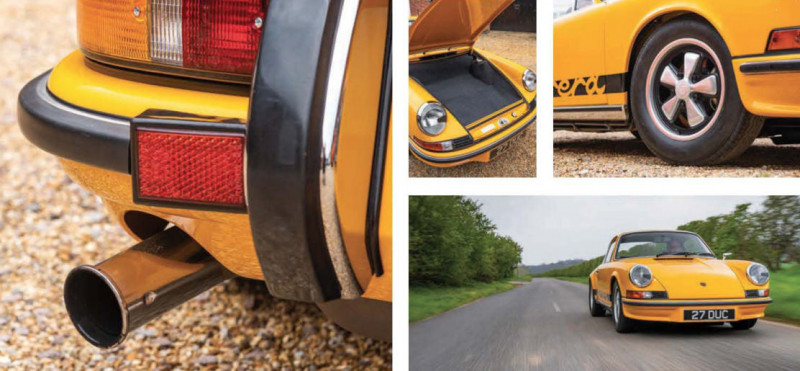
The original RS is delicate, deft and seems to require barely any steering input to turn into a corner. Every command provokes a response. Jump on the power during an exit and the rear does the classic ‘911 squat’. For the first time, you appreciate what the 2.7-litre air-cooled flat-six can really do. And, unlike many of its 1970s contemporaries, there is little doubt the RS really did (and does) have a full 210bhp. Even today, it feels properly fast. At the time of production, it must have felt incredible. Forget its immediate competition, such as the Ferrari Dino 246 GT — even the 365 GTB/4 Daytona and 512 Berlinetta Boxer wouldn’t have kept up on a winding road. With great power comes great responsibility, as the saying goes. I suspect that in many ways, for this now fully restored early RS 2.7, it’s days of hard charging are over, such is its inherent value. Then again, the great thing about the air-cooled 911 is just how many come within ninety percent of the RS’s hundred. The G-series, for instance, carried over dynamic aspects of the original RS and broadly similar power. Bottom line, if the RS is the full she-bang, then a 911 SC is an easy ninety-percent without the baggage of rarity and reputation.

Jump a few generations and we find ourselves with the 997 GT3 RS, also known as Kevin’s impulse buy. “I saw it being advertised for sale through RPM Technik,” he reveals. “I just had to have it!” Fair enough — in orange, this 911 certainly shouts. At under ten thousand miles, it’s also a timewarp example and completely unmolested, save for custom orange houndstooth seat detailing expertly executed by Dave the Trimmer. Back at the start of this ramble, I made clear the first-generation 997 GT3 RS was my favourite modern 911. This suggests there is a classic, air-cooled 911 trumping it. Actually, there isn’t. Not even the RS 2.7. This is it. It must be good then?!
The 997 is the absolute sweet spot of the modern 911 range, building on the good work of the 911 996, but delivering the perfect blend of size and performance. The 991 and 992 are, frankly, too big, too heavy and, in GT form, just too fast for the road. Oh, and then there’s the tech. Too much of all that, thanks.
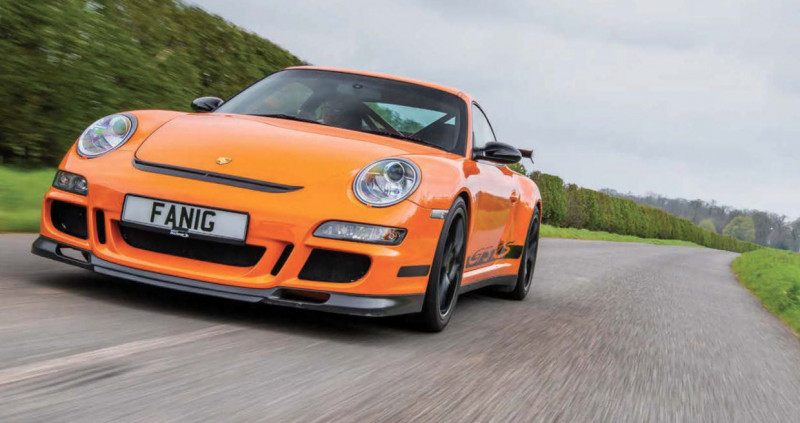
Above and below Early 997 GT3 RS straddles the tipping point between the analogue and digital eras of sports car production.
The 997 GT3 RS was obviously the first 997 to wear the RS badge. Essentially, it was a homologation special built in to legitimise the era’s RSR endurance racers, which were rolling out of Weissach for works and customer teams. A key difference to the 997 GT3 is the GT3 RS’s wider track (increased by thirty-four millimetres), modified rear suspension, a rear axle line pushed back by five millimetres, a stiffer Carrera 4/4S-derived bodyshell and a twenty-kilogram weight reduction, achieved by way of increased use of composite components and the adoption of a Perspex rear window. Even so, the GT3 RS’s 1,375kg kerb weight isn’t exactly svelte. It rather puts the 1973 RS’s 1,075kg into perspective. Once again, though, different times.
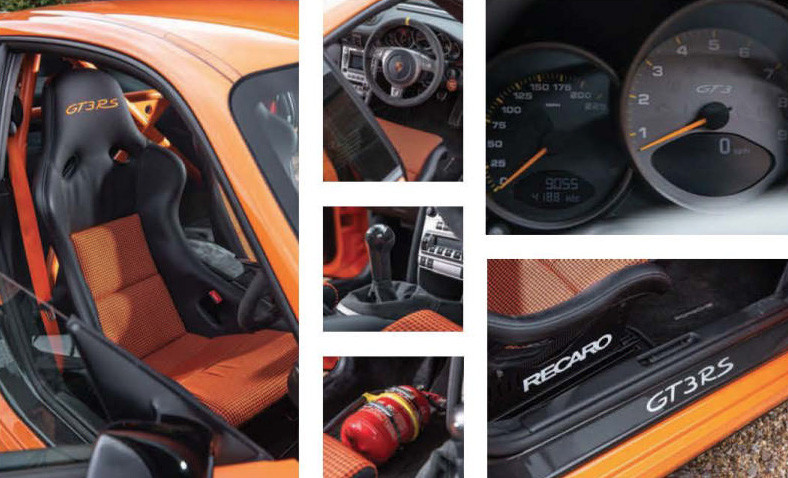
Power-wise, the hallowed Mezger 3.6-litre boxer is tweaked to 415bhp (nearly double that of the RS 2.7), which is the maximum the 3.6-litre flattie ever produced before Porsche was forced to increase capacity to 3.8 litres for future GT3 and GT3 RS generations, and, finally, to four litres for the final iteration of the 997 GT3 RS. Kevin’s orangey example is slowed by Porsche Ceramic Composite Brakes (PCCB), distinguished by yellow calipers, making use of six pistons at the front and four at the rear. The brakes are partially obscured by nineteen-inch Cup wheels rolling on Michelin Pilot Cup Sport tyres.
Working between wheel, tyre and bodyshell is Porsche Active Suspension Management (PASM), which is as high-tech as the first-generation 997 GT3 RS gets. Granted, active suspension is right up there, but in all other areas, this RS is still relatively passive/analogue, with only basic traction control and Porsche Stability Management (PSM) to keep it on the road. Both are easily overridden, but even when activated, only intervene when absolutely required, such as in greasy or wet conditions. In terms of performance, this near twenty-year-old 911 is still right up there, capable of 8,400rpm, near 200mph and sprinting from standstill to sixty in 4.2 seconds. Those are, however, just the numbers — as ever with a 911, the driving experience is about rather more.
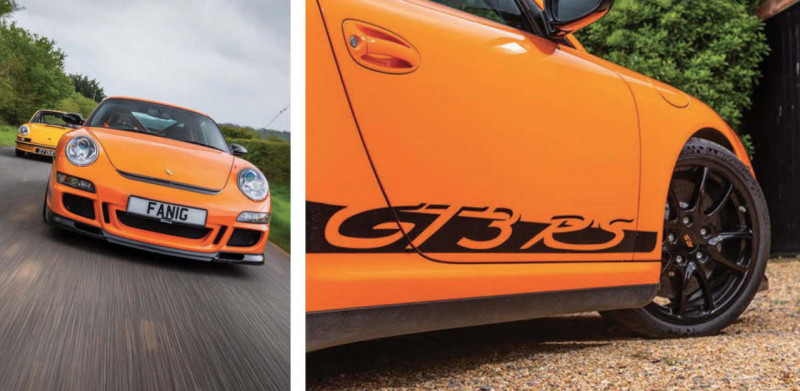
Above First-gen 997.1 GT3 RS was an impulse buy after Kevin spotted it in the listings of RPM Technik, the very specialist he has charged with taking care of ongoing maintenance.
It’s been a good few years since I’ve driven a 997 GT3 RS, but previous occasions are still laser-etched in the memory. Especially indelible is a three-day encounter involving a track day at Snetterton and time split between haring across Northumberland and the North Yorkshire Moors in Porsche Great Britain’s GT3 RS press car, wearing registration number RK07 YGT. This 997 is rather more famous for its Top Gear tellybox appearance, when Clarkson and his esteemed colleagues set off in order to find the world’s greatest driving road. Romania’s TransFagarasan mountain stretch was their conclusion, although I was quite satisfied with my adventures on Blakey Ridge.
What makes the 997 GT3 RS so special, then? Why is it so much more than the sum of its parts? Well, as mentioned earlier, it was the first RS to utilise a Carrera 4/4S body, allowing for a wider track. This was a genuine homologation car, too. In other words, the rear suspension was modified for a reason, the split lower arms giving scope for tweaking and adjustment. The resulting wider and longer platform, allied to roll-resistant electronic dampers, made for a 911 chassis with new levels of stability, balance and composure.
IMPROVING THE RECIPE
The very best cars are the ones you can just relax into. It takes a very special car, however, to make this entirely possible on UK roads. I know I’m always banging on about it, but if a Porsche (or, for that matter, any other sports car) doesn’t work on a UK backroad, then it’s effectively not fit for purpose. The requirements for meeting this rule largely come down to overall size and the ability to rock ‘n’ roll. Performance is obviously a pre-requisite, but not so much as to be effectively wasted.
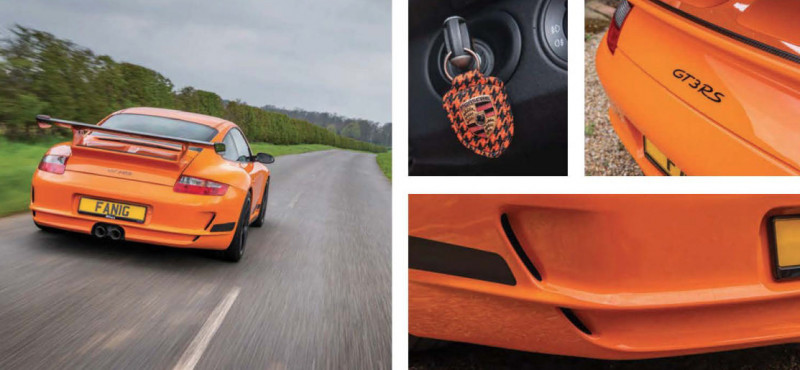
In my opinion, the 997 GT3 RS nails all of these parameters, while also bringing a whole new dimension and dynamic to the 911s handling. It all comes flooding back when in the driving seat of Kevin’s supreme example.
It’s good to return to the model’s tight-fitting carbon buckets. The driving position is perfection, as is vision through the upright screen. Check the interior mirror and you’re greeted with the purposeful scaffolding of the rear half-cage. Beyond lies the rear wing. It was pretty wild two decades ago, but seems almost subtle by current GT3 RS standards.
“Start me up,” as the Stones did sing. The Mezger-six sounds gruff, tappety and slightly moody, but starts to smooth out as the oil thins, settling into that typically gravelly, offbeat, lightweight flywheel chatter on idle. The gearbox is tight and short. The clutch requires a smidgeon of slip to get rolling. Like the engine, it needs warmth to loosen up. It’s second nature to hit the Sport button, which opens the Sports exhaust and boosts torque, while also slackening the traction control’s influence. It also defaults immediately to PASM’s track-focused setting, but for road use, this can be overridden, via a separate damper-logoed switch. The mantra: Sport on, dampers off.
The crowded south’s roads might not be up to remote northern standards (or Romanian, for that matter), but it’s surprising what you can winkle out in this neck of the woods. Kevin’s knowledge of the locale is key to this re-match. Up the pace and its familiar GT3 RS territory: a revacious engine that pulls and pulls, but is slightly tempered by its long(ish) gearing. Tactile hydraulic steering reads the road, just like the RS 2.7 does.

The 911’s later electrically assisted steering feels artificial and detached by comparison, no matter what Porsche might claim.
And just as it did all those years ago, the 997 GT3 RS starts to divulge its hidden talents and dynamic secrets. Gradually, something major begins to reveal itself. This GT3 RS doesn’t have a back end feeling as though it is constantly moving or pitching its weight around. It’s still there, obviously, but it feels as if its sole purpose has shifted to help turn the car into corners. It’s something 911 meisters have always exploited, but here, with the 997 GT3 RS, it appears to do this for you. And there’s no hanging on tight, with knuckles clamped to the steering wheel. This is a car you can blend with and move with. It’s fast, but not overwhelmingly fast. Its power can be harnessed and manipulated, even played with.
For a Porsche built with homologation in mind, and without too much consideration for road use, the first-generation 997 GT3 RS makes for a remarkable all-rounder, just like the Carrera RS 2.7.
The later 997 GT3 RS 3.8 was considerably more hardcore for no real gain, losing its road-going compliance. As highlighted, the final edition in the series featured a four-litre flat-six and was less extreme, but its rarity (only six hundred were manufactured) makes it near unusable for most.
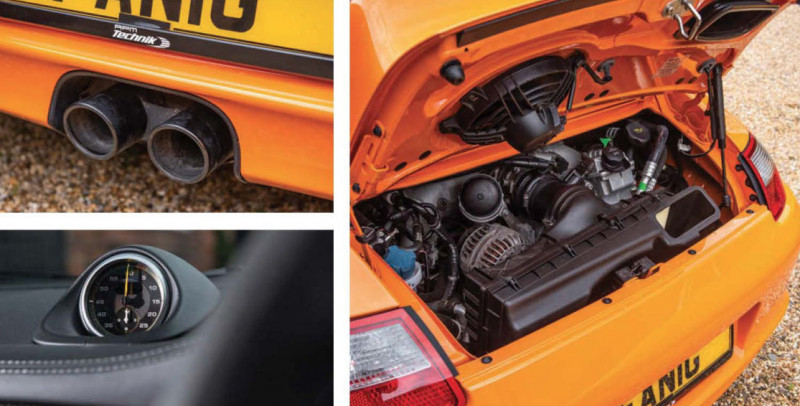
The original 997 GT3 RS somewhat hides in the shadows, but is actually rarer than the second-generation 997 GT3 RS (1,500 units built versus 1,678). The cherry on the cake is this: the early model is the relative bargain of the trio. Time to hand this awesome orange 911 back to Kevin, who has been more than generous with his time and cars. There is always something magical about time spent driving Porsche’s GT and RS models, though some elicit more wonder than others. The Carrera RS 2.7 absolutely deserves its status, and is genuinely a very special thing. Making the great jump to the 997 generation at the expense of the 911 964,911 993 and 996, might seem like a big ask — the 964 Carrera RS took the ‘road racer’ concept to the limit, while the 993 Carrera RS dialled it back again. The early 996 GT3 (a much underrated and currently undervalued car) would be second to my 997 GT3 RS drive. The later 996 GT3 RS is just a tad too extreme.
All this leaves the original 997 GT3 RS somewhere in the middle. Or, perhaps, the sweet spot? We’re dealing with a normally aspirated 911 and largely analogue specification. Even PASM (once you work out which settings suit you like best) keeps modern technology in check by not sacrificing driving involvement or feel. And while making a race car is no great achievement, homologating one for street use and making it a success away from the track is bordering on alchemy. Genius, even.
This is what connects the Carrera RS 2.7 with the 997 GT3 RS. Not all Rennsports are equal, not all are great, and not all were made to work on both road and track, but of those that were, despite being separated by more than three decades, it’s these two that are brothers in arms.
CHECK THE INTERIOR MIRROR AND YOU’RE GREETED WITH THE PURPOSEFUL SCAFFOLDING OF THE REAR HALF-CAGE
Porsche released the now legendary 911 Carrera RS 2.7 in readiness for the 1973 model year. Fifty years on, we can look back at a strong suite of road-legal, race-inspired 911s able to trace their DNA back to the ducktailed homologation special. Today’s Rennsports, however, have become somewhat burdened by size, weight and a wealth of electronic driver aids, all of which are dictated by modern safety standards, a result of engine output increasing exponentially. Not so with the first-generation 997 GT3 RS, which expertly straddles the analogue and digital eras of Porsche production. With this in mind, we brought together one of the first five hundred Carrera RS 2.7s (build number 433, in fact) and a super-low mileage 997 GT3 RS. You might think comparing 911s separated by more than three decades is a tough call, but these zesty coupes have more in common than one might consider at first glance. This features a pretty even split of retro and modern Porsches — not only do we spend quality time (both on- and off-road) with the new 992 Dakar, we return to New England to check out the trio of air-cooled classics owned by Def Leppard guitarist, Vivian Campbell. Enjoy the article.


